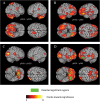Heterogeneity of structural brain changes in subtypes of schizophrenia revealed using magnetic resonance imaging pattern analysis
- PMID: 25261565
- PMCID: PMC4266302
- DOI: 10.1093/schbul/sbu136
Heterogeneity of structural brain changes in subtypes of schizophrenia revealed using magnetic resonance imaging pattern analysis
Abstract
Background: Schizophrenia is a multifaceted mental disorder characterized by cognitive, perceptual, and affective symptom dimensions. This heterogeneity at the phenomenological level may be subserved by complex and heterogeneous patterns of structural abnormalities. Thus, delineating such patterns may improve the insight into the variability of disease and facilitate future magnetic resonance imaging-based diagnosis.
Methods: We aimed to identify structurally complex signatures that directly differentiate patients with predominantly negative (pNEG), positive (pPOS), and disorganized (pDIS) symptoms using Optimally-Discriminative Voxel-Based Analysis (ODVBA). ODVBA is a new analytical framework for group analysis, which showed to have superior sensitivity and specificity over conventional voxel-based morphometric approaches, thus facilitating the identification of subtle neuroanatomical signatures delineating different subgroups.
Results: pPOS were characterized by pronounced gray matter (GM) volume reductions in the ventromedial prefrontal cortex (vmPFC), which herein is defined to include the orbitofrontal cortex, and in occipitotemporal GM and parts of the lingual gyrus. pNEG was found to have vmPFC reduction but to a lesser degree than pPOS and with a relative sparing of the more medial vmPFC regions, compared to pDIS; it also had significantly less cerebellar GM. pDIS showed relatively highest GM volume preservation among three subtypes.
Conclusions: Although a common prefronto-perisylvian GM reduction pattern was present at the whole-group level, marked morphometric differences emerged between the three subgroups, including reduced cerebellar GM in pNEG and reduced vmPFC and occipitotemporal GM in pPOS. Besides deepening our insight into the neurobiological underpinnings of clinical heterogeneity, these results also identify important imaging biomarkers that may aid patient stratification.
Keywords: ODVBA; patient stratification; volume reduction; voxel-based morphometry.
© The Author 2014. Published by Oxford University Press on behalf of the Maryland Psychiatric Research Center. All rights reserved. For permissions, please email: journals.permissions@oup.com.
Figures



References
-
- Carpenter WT, Jr, Heinrichs DW, Wagman AM. Deficit and nondeficit forms of schizophrenia: the concept. Am J Psychiatry. 1988;145:578–583. - PubMed
-
- Crow TJ. Positive and negative schizophrenic symptoms and the role of dopamine. Br J Psychiatry. 1980;137:383–386. - PubMed
-
- Sigmundsson T, Suckling J, Maier M, et al. Structural abnormalities in frontal, temporal, and limbic regions and interconnecting white matter tracts in schizophrenic patients with prominent negative symptoms. Am J Psychiatry. 2001;158:234–243. - PubMed
-
- Buchanan RW, Carpenter WT. Domains of psychopathology: an approach to the reduction of heterogeneity in schizophrenia. J Nerv Ment Dis. 1994;182:193–204. - PubMed
-
- Andreasen NC, Arndt S, Alliger R, Miller D, Flaum M. Symptoms of schizophrenia. Methods, meanings, and mechanisms. Arch Gen Psychiatry. 1995;52:341–351. - PubMed
Publication types
MeSH terms
Grants and funding
LinkOut - more resources
Full Text Sources
Other Literature Sources
Medical

